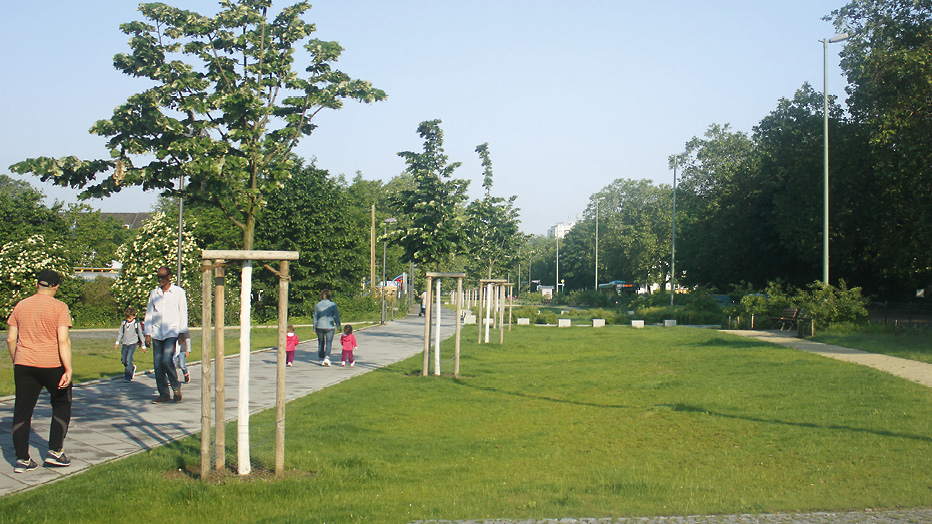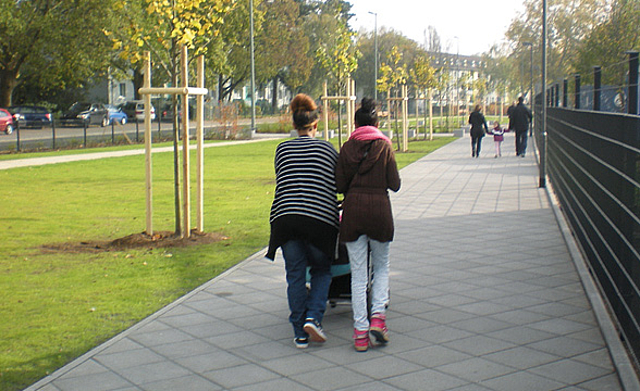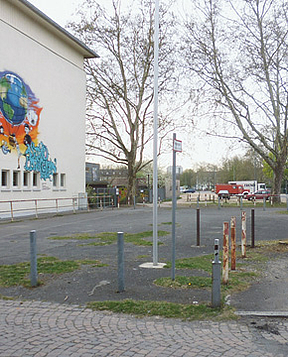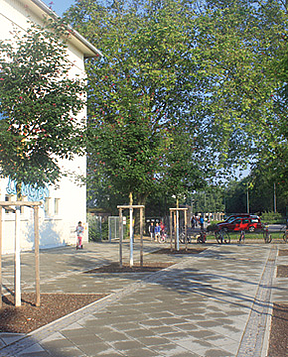Project Profile
Project Title: „Green corridor in Platenstraße“
Subject Cluster: Climate Protection and Open Spaces
Project Objectives: Recovery and securing of green areas against the backdrop of climate change and the growing demand for housing. Sustainable open space design with public participation, equitable distribution of green areas – also in the suburbs und in socially-disadvantaged city districts.
GPS coordinates:50.138583, 8.661666
Planning/Construction Period: 2007 - 2015
Project Participants: Parks Department, Municipal Real Estate Office, Roads Department, Traffic Department, City Treasurer’s Office, Mainova AG, ABG FRANKFURT HOLDING, local District Council, Astrid-Lindgren School, Integrative School, Kita Morgenstern, KT 92, Ginnheim Community Centre e. V., Zarakali Children’s Circus, BMX Club Stahlfräse
Total Surface Area: approx. 5,700 m²
Costs: € 575,000
Creating local green and recreational areas is a question of using “forgotten“ spaces and their potential in view of a growing population, the rise in demand for housing, the economic growth and a rapid increase in traffic, all of which are competing for room. Platenstraße is one such example.
Platenstraße in the Ginnheim District was built in the 1960s as a four-lane feeder road. It passes through the eponymous district, which had been the former US Army Housing Area. Following their departure in 1994 the district passed into municipal ownership and many large families, increasingly with a migrant background, moved in. The street space remained unchanged and illegal parking and dumps without any recreational value sprang up.
Networking green spaces
Ideas from planning workshops in Frankfurt’s “Urban Development Initiative 2030“ showed the potential of these“ forgotten“ open spaces. To the South of Platenstraße, the Miquelanlage and Grüneburgpark form a green link to the city centre. To the West and East, a green corridor leads to Sinaipark and via the Fritz-von-Unruh-Anlage to the valley of the Nidda and the Green Belt.
Platenstraße has been completely re-designed as a green corridor. Street areas have been restructured and the paved surfaces reduced to a minimum. Sensitive planning and respect for established structures helped preserve the character of the district.
Involving the residents
To ensure wider acceptance of the new park, the Ginnheim group of Local Agenda 21 developed a public participation process, which was accompanied by the Parks Department.
The District working group developed a “Learning and Culture Mile“ as a neighbourhood meeting place with offers for children and young people. The Zarakali children's circus and the bike park were involved as were the neighbouring kindergarten and the Astrid-Lindgren Primary School. Discussions in the local advisory committee and the work of the Neighbourhood Office and the District working group kept the project constantly in the public eye. Plans were explained during several on-site visits and in the District working group meetings. Interested parties expressed their wishes which resulted in the installation of the chess board, the boule area and the public bookcase. The daily newspapers and the local Ginnheimer Siedlungszeitung reported about the project on several occasions.
Creating green with recreational value
Where previously gravel and asphalt prevailed there is now 3,200 m² of new green spaces with shrubs, trees and meadows. In a few years, the avenue with its large-crowned silver linden along the footpath will offer pleasant shade. The functional, top-quality and robust facilities do justice to the intensive use of the areas. Existing porphyry plaster was re-used around the benches. The illuminated footpath runs parallel, but at a small distance, to the street along the border to the neighbouring properties into the residential areas on Franz-Werfel Straße and Sudermannstraße. It has become a safe and attractive foot and bike path connection – especially for schoolchildren.
Keeping an eye on climate change
Which trees are planted is based on the experience of the Parks Department which has been analysing the reactions of trees along roads to global warming for several years. Silver linden and Montpellier maple are heat-tolerant trees. A building lot was left unused to close the gap in the planned tram line. The tracts of grass were sunken slightly to allow rainwater to drain from the adjacent paved areas. This relieves the drainage system in the event of heavy rainfall.

Urban Climate
De-sealing and re-greening; improving micro-climate in the street; new urban climate-friendly trees; rainwater infiltration.

Green spaces
Creating high-quality designed green spaces in socially disadvantaged districts; networking with other green spaces.

Meeting place
Opportunities for neighbourly dialogue; activities for children and young people; safe foot and bike paths; high level of identification among the residents with the green corridor.
Parks Department Frankfurt am Main
Heike Appel
Tel +49 (0)69 212-30209
heike.appel(at)stadt-frankfurt.de





